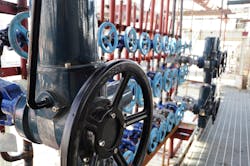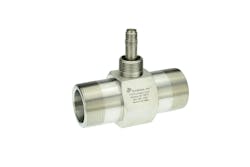Why this article is worth reading:
- Learn how a move from time-based filling to precision flow meters improved batch accuracy by 98% and increased daily throughput by 14%.
- Understand how flow measurement improvements create ripple effects throughout production, from reducing labor dependency and operator errors to eliminating post-batch corrections and freeing up workers for higher-value tasks.
- Get insights on how addressing water measurement accuracy can eliminate multiple downstream problems including quality rejections, formulation inconsistencies and production delays.
For many batch manufacturers, accurate flow measurement can make or break production. This is especially true in industries where water or water-based solutions make up most of a formulation. While water is a relatively easy fluid to handle due to its low viscosity, achieving consistent volume delivery across hundreds of batches presents a unique challenge, especially when tight tolerances and automation are involved.
This was the case for our client, a manufacturer of environmentally friendly cleaning products based in the Pacific Northwest. Known for their eco-conscious floor cleaners, glass sprays and degreasers, they were scaling up production due to increased demand from retail and institutional clients. But as batch volume increased, so did their issues with flow accuracy and production efficiency.
Inaccurate flow measurement slowed scale-up
Our client’s production relied on a manual batching system using time-based filling for water additions. While this approach had worked on a smaller scale, it became a bottleneck as batch sizes grew and new mixing tanks were added.
Their legacy setup process involved: opening a valve for a fixed time to let water flow into a mix tank; monitoring the fill level by sight glass or operator estimates; and adjusting batches post-fill if the level was off.
This system introduced several problems:
- Inconsistent batch sizes due to fluctuations in water pressure.
- Manual labor dependency increased the chance of human error.
- Time inefficiencies as operators often overfilled “just to be safe”.
- Difficulty scaling into automated production lines.
While water isn’t expensive, inaccurate dosing impacted the entire formulation, requiring last-minute adjustments to concentrate ratios. Worse, it caused variability in product consistency, occasionally leading to quality analysis rejections.
Our client needed a better way to manage the largest and most frequently used ingredient in their production process: water.
How flow meters solved the problem
Based on the application, the HA Series high-accuracy turbine flow meters were recommended based on their performance with low-viscosity fluids like water and water-based solutions, high repeatability and accuracy (±0.5% of reading), durable 316 stainless steel construction, fast response time to support automated valve cut-offs, and compatibility with batch controllers and PLC systems.
The HA Series meters were installed inline on the water feed lines for the company’s three main batching tanks. The meters were connected to the facility’s existing PLC infrastructure and integrated with an automated valve control system.
The new system was programmed to measure the precise volume of water needed for each recipe. Once an operator selected the batch type on a touchscreen HMI, the flow meter and valve system would open the water valve, measure real-time volumetric flow and automatically close the valve once the target volume was reached.
Measurable gains in efficiency and accuracy
With the turbine meters installed, batch water additions were within ±0.5% of target, compared to deviations of up to ±5% with the manual timing method. This improved batch accuracy by 98% and had a direct impact on product quality, reducing the need for post-batch corrections.
Automating the water filling step shaved an average of eight minutes off each batch, allowing the plant to run more batches per shift. This translated into a 14% increase in daily throughput across all product lines using the system.
The automated system also freed up operators to focus on value-added tasks, such as staging ingredients or preparing packaging. Water additions no longer required full-time supervision, reducing labor costs and minimizing the risk of operator mistakes.
And, unlike the company’s older paddle meters, which often failed due to debris or mineral buildup, the HA Series meters required little to no maintenance. The stainless-steel construction held up well.
Mark Weiss is with Turbines Inc.
More process industry coverage from Automation World:
About the Author

Leaders relevant to this article:

